#as this androgynous being who look neither male nor female
Text
i think i... kinda get it now why angel devil looks like that
#because he kinda represent the images of what many humans wants to see when they are gonna passed away#there's this whole 'angel of death appears as your beloved so it'll be easier to detach your soul from your mortal body'#thing that appears in some religious texts so#i think fujimoto might based of him off of that#and also the common depictions of humanoid angels in biblical stories#as this androgynous being who look neither male nor female#and also why that Jacob's ladder reference is there in the opening song with angel devil in gabe's place#chainsaw man spoilers
1 note
·
View note
Text
A Brief History of the LDS Church's Transgender Teachings and Policies
Gender identity and gender roles are important in LDS theology and practices. For most of the 1800s, church presidents Joseph Smith and Brigham Young had men, women, and children sit separately for all Sunday meetings. Nowadays, some of the Sundays church meetings are still divided by biological sex. Temple worship is also similarly divided.
For decades, the LDS Church believed that in the premortal life, when intelligences were organized into spirits that they may have chosen whether to live as male or female during mortality, and that poor choices during their time on earth could demote them back to a genderless condition. Joseph Fielding Smith, who was made an apostle in 1910 and became president of The Church of Jesus Christ of Latter-day Saints in 1970, was well known for teaching that those who do not reach the Celestial Kingdom will be neither man nor woman, merely immortal beings.
As a teenager in the 1980's, I remember being in Sunday School class and the teacher saying that when we're resurrected we can look down, and if we don't see a penis or vagina then we know we're not making it to the Celestial Kingdom.
Along with this, for many years the LDS Church seems to have viewed all queerness as a form of gender confusion, whether it was a man thinking he's a woman or a man who is attracted to other men.
As the fight over gay marriage ramped up, the teaching about genderless spiritual beings was replaced with the idea that gender is forever and this was incorporated into the 1995 Family Proclamation which states that "gender is an essential characteristic of individual pre-mortal, mortal, and eternal identity and purpose."
The idea is that each of us are a son or daughter of heterosexual & cisgender heavenly parents, and we are meant to become like them. There is a strict binary of spiritual gender identities and gender roles. Ideally, our bodies should be formed in a way that reflects our spiritual body, including our spiritual gender, but the reality of the physical world is that things often don't work as we'd expect them to, but that doesn't change our spiritual gender.
Let me take this moment to point out that the notion of gender being eternal does not exist in scripture, this is a fairly recent evolution.
And while the idea is that gender is an innate and unchangeable part of our souls, the Church has also felt that gender needs to be nurtured, protected, and defended. There have been many rules about what women may wear to BYU and to Sunday services. For many years the advice to leaders on how to counsel with young men experiencing same sex attraction was to have them spend time around manly men and participate in masculine activities, and to not wear androgynous or feminine styles.
For a long time, LDS Church leaders were more aware of homosexuality and focused on this, and their mentions of trans people remained pretty infrequent.
In 1980, Spencer W. Kimball was president of the LDS Church and was outspoken opponent of homosexuality, however he authorized the sealing of a trans woman to her husband in the Washington, D.C. temple. Perhaps in response to this, later that year LDS authorities updated the official General Handbook of Instructions to officially prohibit “transsexual operations.” The handbook stated that “members who have undergone transsexual operations must be excommunicated” and that “after excommunication such a person is not eligible for baptism.”
I first got access to Handbook 1 in 2016, and excommunication was still the standard, although it said "elective transsexual operations" (not sure when the word "elective" was added). Surgery was the boundary line which if crossed would result in excommunication. However, the phrase "elective transsexual operations" recognized there are some circumstances where such operations are required or aren't the choice of the individual. For example, a man whose genitals were injured and couldn't be kept, or an intersex person who had surgery performed on them as an infant or child.
Any individual who was considering "elective transsexual surgery" was not allowed to be baptized, but for an individual who had undergone "transsexual surgery" and now wanted to be baptized, it had to be approved by the First Presidency. If they were allowed to be baptized, they would not be allowed to receive the priesthood or participate in gender-separated temple rites (which limited them to doing baptisms).
There was some wiggle room on whether top surgery is considered "transsexual surgery" and depended on the local leader's interpretation. There was no policy on transitioning in ways that didn't involve surgery, such as hormone therapies, “cross dressing,” or other means of living out one’s gender.
In January 2015, Elder Dallin H. Oaks said, "I think we need to acknowledge that while we have been acquainted with lesbians and homosexuals for some time, being acquainted with the unique problems of a transgender situation is something we have not had so much experience with, and we have some unfinished business in teaching on that." This reflects the growing awareness of trans individuals and showed some humility on his part. Elder Oaks had often spoken out on homosexuality and gay marriage, but this statement was thoughtful and many took it as cautiously optimistic.
Some transgender Mormons in explaining that their bodies do not reflect their gender identity would point to the Family Proclamation which says "gender" is eternal but not necessarily their sex. In response, in 2019 Elder Oaks said that “the intended meaning of gender in the family proclamation and as used in Church statements and publications since that time is biological sex at birth.”
In 2020, a major revision of the Church's general Handbooks were made. Handbook 1 (which was only available to bishoprics, stake presidencies, and General Authorities) was combined with Handbook 2 and put on the Church's website for all to see. This revision included major changes for transgender members.
The term "elective transsexual surgery" was gone, and now any social, medical or surgical transitioning would bring restrictions. Many saw this as more restrictive, it took away the space to transition in ways other than surgery while remaining in good standing as a member. Some saw it as a step at being more accommodating as excommunication was not the de facto punishment for transitioning. A church member could decide if transitioning was important enough to them that they'd be willing to be without a temple recommend.
The 2024 Handbook update seems like they felt some local church leaders had taken things further than had been anticipated, and so they had to plug in the gaps from the 2020 Handbook that leaders had used to be inclusive and accommodating of their trans members. Now members who transitioned in any were not allowed to be baptized, restricted from holding almost all callings, specified which meetings & activities they may attend, forbids trans youth and young single adults from overnight activities, and even has specific rules about under how a trans person may use the restroom.
65 notes
·
View notes
Note
This is maybe a dumb question, but looking at the portraits of Hervey, I have a hard time noticing anything about how he's dressing that seems out of the ordinary or especially more 'feminine' for the time period (barring that one where he just has his coat buttoned super low and his whole shirt out?). Am I missing some obvious detail (material they were made out of maybe?) or was the his effeminacy/the perception of him as effeminate just more based on behavior than 'presentation'?
Not a dumb question at all. It was combination of his sexuality, his diet, his androgyny as well as his clothes & makeup. While Hervey's femininity was almost certainly exaggerated in satire written by his enemies there was some basis to this satire.
Sexuality
In the 18th century there was an association between effeminacy and sodomy. I don't think we can discount the role the rumours surrounding Hervey's sexuality played in the public's perception of him. William Pulteney's 1731 pamphlet A Proper Reply to a Late Scurrilous Libel satirises Hervey as Mr. Fainlove. Pulteney describes Fainlove as a "delicate Hermophrodite", a "pretty, little, Master-Miss" and insinuates that he's a pathick who "enjoys every Moment and Fruits of his Guilt". The 1739 pamphlet The State of Rome, Under Nero and Domitian satirises Hervey as Sporus (an allusion to Pope's satire of Hervey) describing him as a "Male-female Thing," who is "Fit only for the Pathicks loathsome Trade".
Pope's choice to satirise Hervey as Sporus in An Epistle from Mr. Pope, to Dr. Arbuthnot (1735) was itself a comment on Hervey's sexuality. Sporus being the boy that Nero is said to have castrated and taken as a wife.
Diet
Hervey was epileptic and suffered from a chronic colic. He details his medical history in An Account of My Own Constitution and Illness. At the recommendation of his doctor's George Cheyne he adopted a milk and vegetable diet. Cheyne believed that such a diet was "absolutely necessary for the total Cure of the Epilepsy” and also prescribed milk and vegetable diets in cases of “extreme Nervous Cholicts”. (The English Malady, p167 & 254) Hervey ate no meet for three years before reintroducing white meet. This diet was seen as effeminate by his contemporaries. Lady Louisa Stuart cites his refusal to eat beef as an example of the “extreme to which Lord Hervey carried his effeminate nicety”. (Stuart wrote this anonymously in the introductory anecdotes included in the 1837 edition of The Letters and Works of Lady Mary Wortley Montagu.)
Hervey also drank "ass’s milk with powder of crab’s eyes and oyster-shells" for his heath. This is mocked in the poem The Lord H-r--y's First Speech in the House of Lords (1733-4) that calls him "a perfect curd of ass's milk." Alexander Pope included a similar line in An Epistle from Mr. Pope, to Dr. Arbuthnot (1735) describing him as a "mere white Curd of Ass's milk".
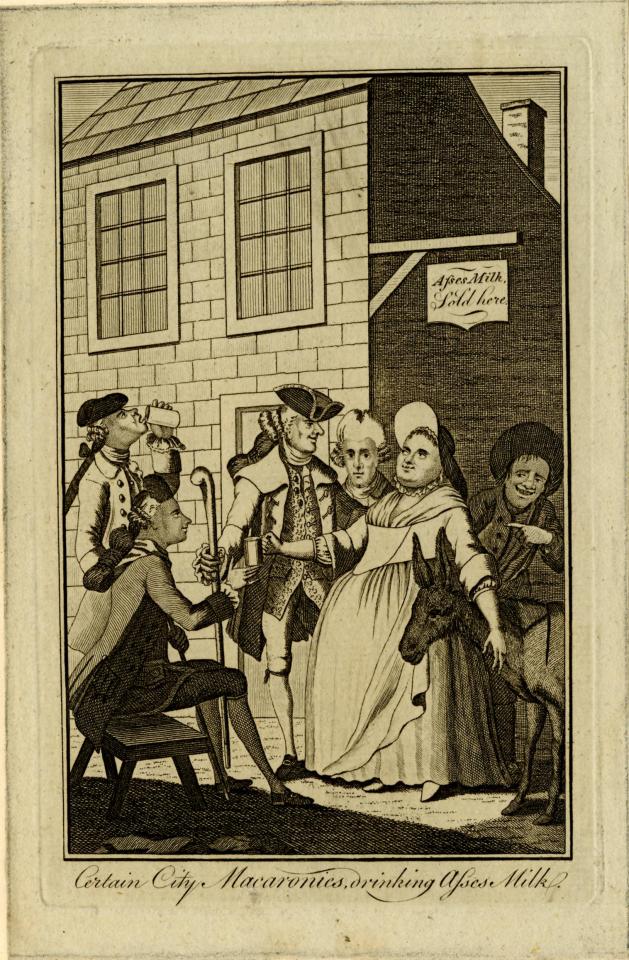
[Certain City Macaronies drinking Asses Milk, print, c.1772, via The British Museum.]
The association between effeminacy and asses milk features in the satirical dialogue The City Macaronies drinking Asses-milk, at the Lacteum, in St. George's-fields published in the November 1772 edition of the Oxford Magazine which was accompanied by the above illustration. The dialogue mocks macaroni for drinking asses-milk as a treatment for "nervous cases" and "hysterics" claiming that it's "delicate men" such as the macaroni "whose fine feelings are sensible of the slightest pressure, that are acquainted with hysterics". The son of the milk woman wonders aloud whether the macaroni are men or women. His mother tells him "they're neither, they are a kind of half and half breed."
Androgyny
With his slim figure and a bit of a baby-face Hervey was considered to be naturally androgynous. When Lady Deloraine said to him and Miss Fitzwilliams that "in her opinion a woman could never look too much like a woman, nor a man too much like a man" Hervey admitted that "considering the two people she said this to, it was certainly well said; and I can forgive her having bragged of it to every creature she has seen since" (Hervey to Stephen Fox, 18 September 1731)
Satirical descriptions of Hervey liken him to a cherub or a fairy describing him as pretty, little, soft, dainty, delicate.
In A Proper Reply to a Late Scurrilous Libel (1731) Pulteney satirises Hervey as "pretty Mr. Fainlove" who he describes as a "delicate Hermophrodite", a "pretty, little, Master-Miss", a "pretty, little Scribbler", and comments that he shouldn't "sully those pretty Fingers with Ink" that "a Fan would become them much better than a Pen."
The Lord H-r--y's First Speech in the House of Lords (1733-4) describes him as "the softest, prettiest thing". In An Epistle from Mr. Pope, to Dr. Arbuthnot (1735) Pope describes him as having a "cherub's face". Tell-tale Cupids (1735) satirises him as the "pretty baby fac'd Lord Dapper".*
In A Fairy Tale (1743) by Horace Walpole depicts Hervey as a literal fairy describing him as a "Dainty little Figure", "most delicately Fair and light" who "would have been vastly Pretty if it’s cherry-lips had ‘nclos’d any Teeth".
*quoted in Lord Hervey: Eighteenth-Century Courtier by Robert Halsband
Clothes & Makeup
Pope didn't describe Sporus as a "bug with gilded wings" and a "Fop at the toilet" because of Hervey's natural androgyny, clothing & makeup absolutely played a role in the public perception of him.
The Duchess of Marlborough described Hervey as a having "a painted face, and not a tooth in his head". Pope described him as "painted Child of Dirt that stinks and stings". And the The Court Garland refers to him as "Thou powder-puff, thou painted toy". (see The Opinions of Sarah Duchess-Dowager of Marlborough p42, An Epistle from Mr. Pope, to Dr. Arbuthnot & Lord Hervey: Eighteenth-Century Courtier by Robert Halsband p138)
The fashionable look of the period required pale clear skin, flushed red cheeks and dark eyebrows. While washes and creams were used to achieve clear pale skin, white cosmetic paint could also be used to lighten and smooth the skin. Rouge was used to give colour to the cheeks. Burnt cloves could be used to darken the eyebrows. While some of these cosmetics contained lead or mercury not all of them did.
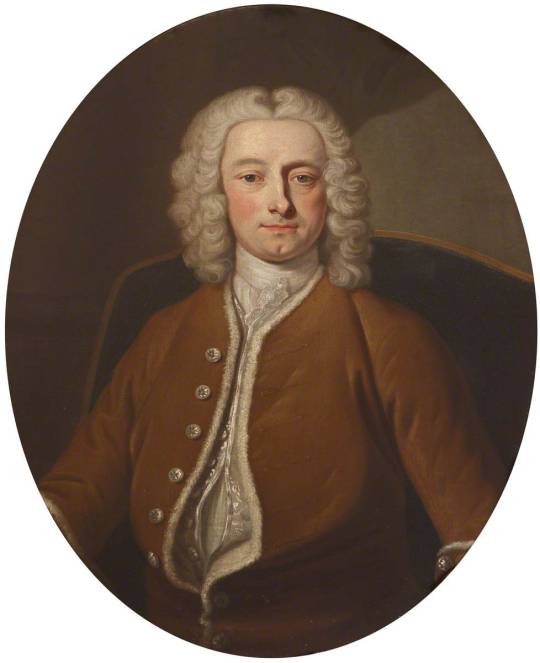
[Lord John Hervey, oil on canvas, c.1741–1742, by Jean-Baptiste van Loo, via Art UK.]
It's hard to know how reliable the accounts of Hervey's makeup use are however his portraits do depict him with this fashionable look (in particular the rosy cheeks of the Jean-Baptiste van Loo portraits and the Enoch Seeman portrait). While modern depictions of 18th century fops will sometimes exaggerate makeup depicting men with pure white faces and almost perfectly round red circles on their cheeks, Hervey's portraits are more accurate to the look these cosmetics were trying to achieve.
The use of cosmetics are highlighted in satirical depictions of effeminate men throughout the 18th century century. As early as 1691 Mundus Foppensis: or, the Fop Display’d was mocking men for the "wanton use" of "Spanish Red, and white Ceruse". In 1773 The Old Beau in an Extasy depicts a "Fop at Sixty two" who uses "Chinese Paint for Artificial Bloom". In 1812 Regency A la Mode depicts the Prince Regent applying rouge to his cheeks while he gets laced into stays. The Court Garland's satire of Hervey is just another example of a satirical depiction of a fop in makeup:
Thou powder-puff, thou painted toy,
Thou talking trifle, H----y;
Thou doubtful he, she, je ne sçai quoy,
By G-d, the K--g shall starve ye.

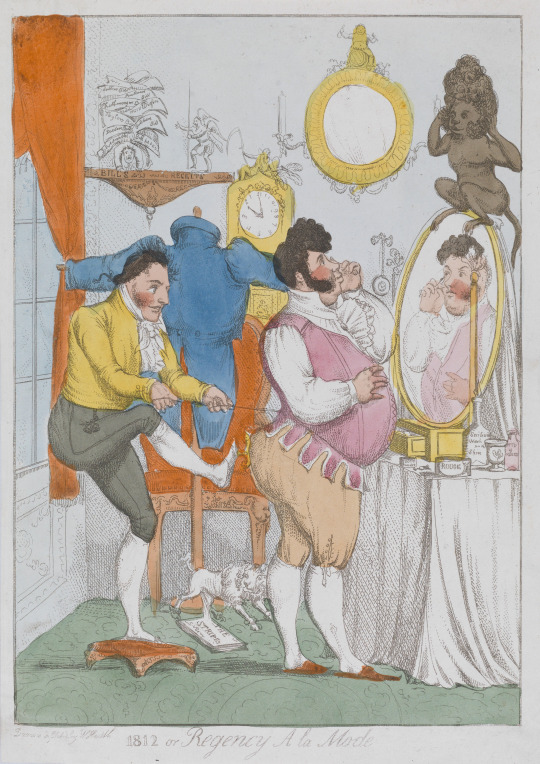
[Left: The Old Beau in an Extasy, print, c.1773, by John Dixon, via Lewis Walpole Library.
Right: 1812, or, Regency A la Mode, print, c.1812, by William Heath, via Lewis Walpole Library]
As for clothing I have to admit I'm better at late-18th century menswear. That being said material and colour seem to have played a role in what was considered effeminate.
A letter to the Read's Weekly Journal or British Gazetteer published on the 8th of May 1731 complains; "Rich and coloured Silks are in themselves effeminate, and unbecoming a Man; as are in short, all Things that discover Dress to have been his Study- 'Tis in vain for a Fop of Quality, to think his Title will protect him." In particular the article criticises poke sleeves and green waistcoats. While poke sleeves are absent from Hervey's portraits the Seeman portrait depicts him wearing a green waistcoat.
Green waistcoats are also mentioned in a story published in the Universal Spectator and Weekly Journal on the 18th of October 1729 describing and effeminate man's clothing as follows:
He had a flower’d pink-colour Silk Coat, with a Green-Sattin Waistcoat lac’d with Silver. Velvet Breeches, Clock’d Stockings the Colour of his Coat, Red-heel’d Pumps, a Blue Ribbon at the Collar of his Shirt, and his Sword-Hilt he embrac’d under the Elbow of his Left Arm,
This green waistcoat is laced with silver. In the Jean-Baptiste van Loo portraits you can see a embroidered silver waistcoat peeking out from beneath Hervey's coat.
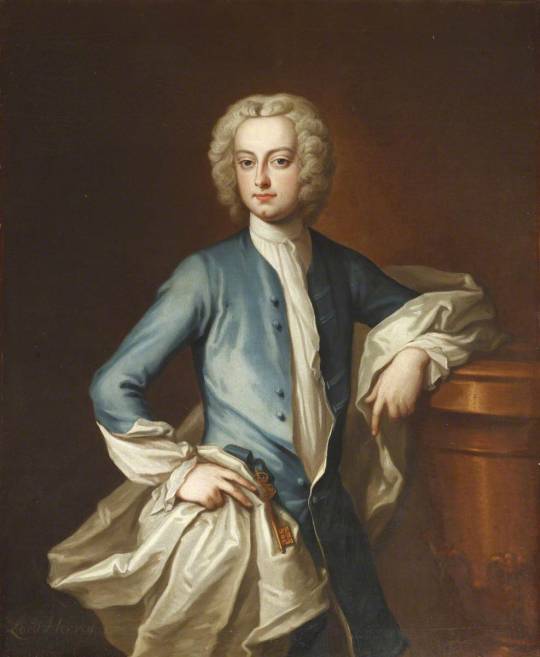

[Left: Lord John Hervey, oil on canvas, c.1737, by John Fayram, via Art UK.
Right: Lord John Hervey, oil on canvas, by Enoch Seeman, via The Collected Verse of John, Lord Hervey]
While the quality of the photo leaves much to be desired I wonder if the coat from the Seeman portrait is supposed to be silver. The coat he wears in the The Hervey Conversation Piece could also be silver but it might simply be grey. Sarah Osborn thought that silver coats looked effeminate. She wrote to Robert Byng on the 2nd of June 1722:
I believe the gentlemen will wear petticoats very soon, for many of their coats were like our mantuas. Lord Essex had a silver tissue coat, and pink color lutestring waistcoat, and several had pink color and pale blue paduasoy coats, which looked prodigiously effeminate.
Hervey wears a "prodigiously effeminate" pale blue, possibly paduasoy, coat (possibly a long sleeved waistcoat?) in the Fayram portrait.
The low buttoned waistcoat is somewhat interesting and consistent throughout his portraits, buttoned particularly low in the Fayram portrait. The effeminate Captain Whiffle from The Adventures of Roderick Random (1748) is described wearing his waistcoat "unbuttoned at the upper part to display a brooch set with garnets" but Hervey is broochless and looking at other portraits from this period the low buttoning doesn't seem to be unusual.
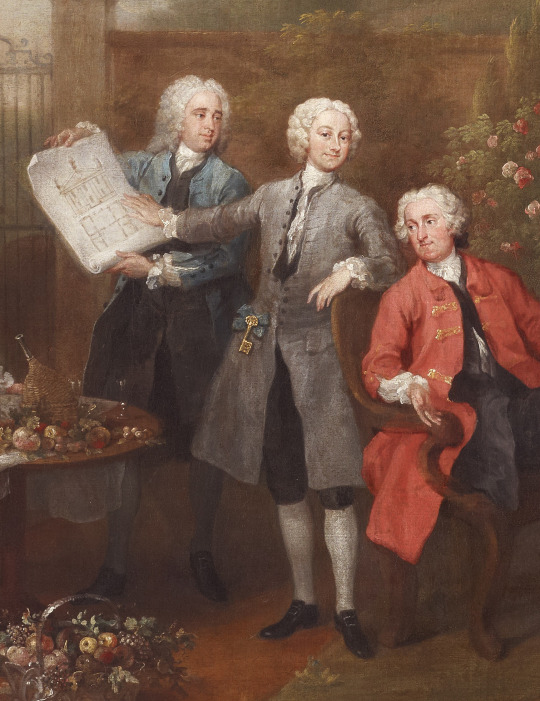
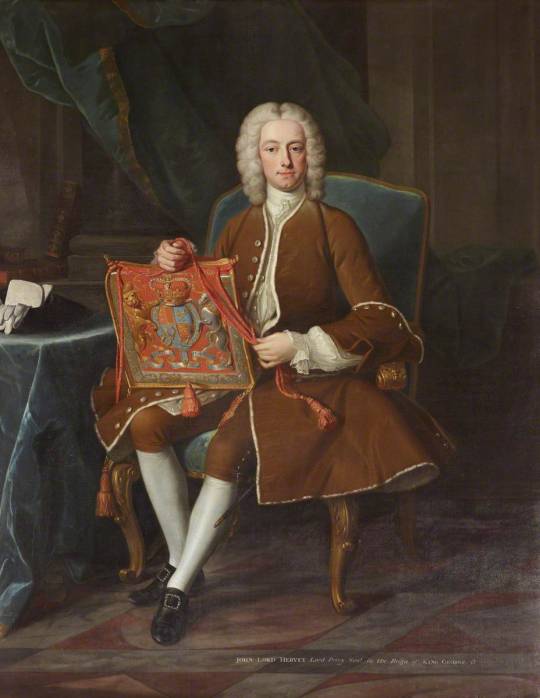
[Left: Detail of The Hervey Conversation Piece, oil on canvas, c.1738-40, by William Hogarth, via Fairfax House.
Right: Lord John Hervey, oil on canvas, c.1741, by Jean-Baptiste van Loo, via Art UK.]
Fur-lined suits like that worn by Hervey in the Jean-Baptiste van Loo portraits were imported from France or Italy and could be very costly. Mary Delany describes Lord Baltimore wearing "light brown and silver, his coat lined quite throughout with ermine" at a ball where "finery was so common it was hardly distinguished". (Mary Delany to Ann Granville, 22 Jan, 1739/40)
Fur-lined suits were somewhat of novelty in England and would become a feature in Grand Tour portraits. Peter McNeil explains in Pretty Gentleman (p123):
The novelty and glamour of new fashion goods generated excited responses to Lyons silk waistcoats, Italian velvets and fur-lined suits. There was a well-established tradition of wealthy men acquiring clothing on the continent and then having themselves painted in them, either in Italy or back in England.
(see Benjamin Lethieullier 1752, Lord Archibald Hamilton 1755-56 & John Scott 1774 all by Pompeo Batoni an artist well know for his Grand Tour portraits)
Hervey's buckles in the Jean-Baptiste van Loo portraits look to be set with paste (glass) or gems (buckles could even be set with diamonds). While it's impossible to tell what Hervey's buckles are set with these buckles could get very expensive. Later in the century macaroni were mocked for their expensive taste in similar buckles. (see McNeil p90)

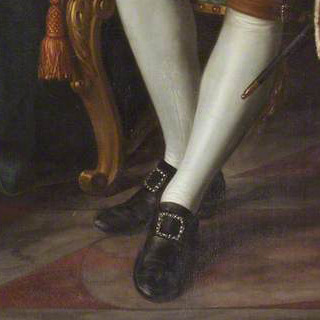
[Left: Shoe buckle, metal & paste, 18th century, British via The MET (83.1.103).
Right: Detail of Lord John Hervey, oil on canvas, c.1741, by Jean-Baptiste van Loo, via Art UK.]
While Hervey was certainly a fashionably dressed man he doesn't take it to the extent you might imagine of the archetypal fop. Satire exaggerates. Hervey's enemies chose their words deliberately to humiliate him. The amphibious thing of Pope's poetry was in reality a chronically ill queer man with a taste for fashion.
#I wrote this post while sick with covid so if anything doesn't make sense I blame the covid#lord hervey#queer history#fashion history
61 notes
·
View notes
Note
Dyou know someone who went on hrt but didn't want to be referred to as female or didn't care? I've kinda recently started not like who I am and I wanna be prettier and there are some things that hrt would give me that sound nice but I dunno if it would be weird or disrespectful to go on it just for that. I've just kinda been seeing a lot of trans girls on my timeline and I can relate to a lot more of their experiences than I would've thought but I don't really want to be a woman and some of the other things hrt gives you don't sound like they're for me. I dunno if the feeling will go away but I hate seeing 5 o'clock shadow on my face, and the thought of being male or female or anything gives me an uncomfortable feeling in my chest and I don't know how to end this ask. If you have no idea how to answer this you can just delete it, thank you.
I don't want to make too many assumptions but this sounds like you might be nonbinary. Nonbinary is being neither male nor female. To answer your question specifically, yes I know quite a few nonbinary people on HRT who prefer presenting less like their assigned gender at birth, and despite using estrogen or testosterone dont consider themselves men or women and just refer to themselves by they/them
Theres a lot you can do via aesthetics to mitigate the dysphoria you feel that doesn't involve hormones in order to look a bit more androgynous (body hair removal, weight loss/gain, changing wardrobe, cosmetics) so I'd always recommend those before immediately trying HRT but its worth looking into if after a bit of a lifestyle change you still feel a little less comfortable as your assigned gender. An endocrinologist could prescribe an anti androgen to start.
Even if you do try HRT and aren't a fan of how it makes you feel and want to stop, you can. It's your body. You're exploring and looking for the best way to be you. People do the therapy to feel better in their own skin, its a personal journey so its impossible to "disrespect" anyone else with your reasons for seeking personal fulfillment and nobody will hold that against you
#ask and mew shall receive#One of the first things I asked my doc was if it was okay to do hrt if I was nonbinary and she was like yeah#You can be whatever gender you want and present how you want but you'll have to manage your sex with hormones
33 notes
·
View notes
Text
Pronouns and Gender in the Good Omens Universe
Neil recently said: “Angels aren't humans or mortals. They don't have genders. There isn't a pronoun you can use for them that's wrong, and unless you can speak in the tongue of the angels there's not a pronoun you can use for them that's actually right. Ditto Demons.”
Obviously, no one's going to debate Neil's pronouncements about the series! The thing is, though, that CONSISTENT gendered pronouns are used in the book, and in the series, and by Neil himself when referring to these characters. There's significant gray area here, no matter how you slice it. So...
(Who are we?
@Princess-Spock: I'm non-binary, specifically genderfluid. My pronouns are they/them for simplicity. My primary gender is agender, and is aroace; I have a wide range of other genders and sexualities.
@Twilightcitysky: I’m an allosexual, queer, cis woman with a background in healthcare, specifically sexual/reproductive health and mental health.)
Pronouns, ideally, should reflect gender… but what is gender? Gender is something we feel inside our heads. For most people, that matches up with their genitals… But not always!
Genitals do NOT determine gender!
Therefore:
A transwoman is a WOMAN, regardless of what genitals she has.
A transman is a MAN, regardless of what genitals he has.
A non-binary person is non-binary regardless of what genitals they have.
A genderfluid person might sometimes have gender that matches their genitals, but at least part of the time does not. (A gender that varies in intensity rather than going between genders is genderflux, not genderfluid.)
A couple of those terms need to be clarified:
• Non-binary means not having a “binary gender,” in other words not being one of the 2 most familiar genders, “exclusively male all the time” or “exclusively female all the time.” (Remember, bi = 2.) Non-binary does NOT mean being genderless! A non-binary person could be genderless/agender… or they might have partial gender, mixed genders, fluctuating genders (fluid or flux), xenogender, or non-specific gender.
Note: Not all non-binary people use they/them. Like everyone else, they get to choose their own pronouns. It's never acceptable to assign pronouns of your choosing to them, or to assume that they must be they/them without confirmation.
• Genderfluid means having a gender that changes periodically; a genderfluid person can have any number (other than 1) or combination of genders. The gender of a genderfluid person might change after a few minutes, or after hours, days, even months. Genderfluidity refers to gender ONLY; it does NOT refer to changes in presentation.
And what is presentation, aka gender presentation or gender expression? It’s what gender a person chooses to portray with their appearance. This can include choosing whether to wear male or female clothing, shoes and accessories… hair length and style… whether or not makeup is used… whether or not body shaping garments are worn, such as a binder to flatten the breasts, or padding to create curves... and whether or not there is facial hair, whether naturally grown or otherwise. If someone has a presentation that differs from their biological sex, they might be trans, or it could be cosplay, drag, cross-dressing, a costume, being gender non-conforming (GNC), as a sociopolitical statement (eg butch lesbians), or just for fun.
Presentation does NOT determine gender!
Some people are forced to wear whatever their culture dictates. Or whatever their family will accept. GNC people choose to not wear clothing that conforms to their gender. For some people, presentation is irrelevant, and they just wear whatever is easiest.
Because there are no elements of presentation that are specifically for any of the non-binary genders, non-binary people are typically left with some form of androgynous or GNC presentation. (@Princess-Spock: it's REALLY tricky to create a look that is neither male nor female, especially for those who, like me, don’t reshape their bodies.)
If a genderfluid person's gender changes when they aren't near their closet, their presentation might not match their gender, even if they’d prefer it to. Sometimes it's a matter of what they can afford; not everyone has the luxury of having multiple wardrobes. (@Princess-Spock: For those of us who are fortunate to have little or no dysphoria, we might skip customizing our presentation much of the time, just for simplicity.)
And just FYI:
Sexual orientation does NOT determine gender!
Specific to the fandom, there is no connection whatsoever between being asexual and being genderless/agender, or to not possessing genitals. Just because someone belongs in one of those categories does NOT mean or even suggest that they belong in the other categories. It is absolutely positively NOT correct to suggest that angels and demons are asexual simply because they don't have gender and/or genitals. (They might still be ace, of course!)
A few useful terms (these are not complete descriptions by any means):
• Asexual, sometimes abbreviated as ace, is a spectrum of sexual orientations in which a person feels little or no sexual attraction to anyone. Being asexual does NOT necessarily mean being aromantic. Also, being asexual does NOT mean not having sexual feelings, or not having and enjoying sex, although these things are true for those who are sex-averse.
• Aromantic is a spectrum of romantic attractions in which a person feels little or no romantic attraction to anyone. Being aromantic does NOT necessarily mean being asexual. And an aromantic person can still make loving connections, exchange affection like kissing or holding hands, and of course still have sex.
• Aroace refers to people who are both asexual and aromantic.
How does all this apply to the Good Omens universe? In the book, it says, “angels are sexless unless they really want to make an effort”; Neil has referred to this for the series as well. Canon isn't explicit, but most of us interpret this as, "they don’t have genitals unless they choose to." Lack of GENITALS is then often wrongly seen as lack of GENDER. Neil said, "Neither the angels nor the demons, as far as I’m concerned, are actually gendered as humans are." But, he uses human gender terms; Crowley is genderfluid, angels are non-binary (it seems like he means that they’re genderless, but that's NOT what non-binary means). Confusingly, in a 2018 post, he said:
"The angels and demons in Good Omens aren’t human, they aren’t male (nor are they female). Not that they couldn’t be male etc if they wanted to make that effort. As it says in Good Omens: ‘For those of angel stock or demon breed, size, and shape, and composition, are simply options’."
That sure looks like, YES, they CAN have gender!
More confusingly, Neil also says that his personal headcanon is NOT canon, canon is only what's in the book and the series... and none of this appears in either place. This makes the gender and thus pronoun issues a tad ambiguous. We agree 100% with Neil that people should embrace their headcanons and allow others to do the same, and so use whatever pronouns they want, and allow others to do the same. Here's how WE see Crowley and Aziraphale's genders and pronouns:
It is absolutely impossible, by definition, for a genderfluid person to be genderless ALL the time. Therefore, if Crowley is genderfluid, he MUST have gender at least part of the time! (And if he can have gender, so can all other angels and demons!)
When Mrs. Sandwich tells Crowley that he's a good lad, and he responds that he's neither, that's in line with what most genderfluid people would say; having a gender some days but not others is different from BEING that gender. Crowley has chosen a male body (male genitals, hairy chest), facial hair, generally masculine attire, and male pronouns, so it's reasonable to assume that his chosen gender is male most of the time.
We assume that he was female when he chose to wear female clothing (an abaya) in the crucifixion scene. He may also have been female during his stint as Nanny Ashtoreth, but that might have just been presentation.
During the scene where he's in heaven in S2, he has a non-binary presentation; the tracksuit is androgynous, and the accessories (headband, sparkly gold tie, fingernails, and toenails) are feminine. He might be experiencing a non-binary gender at this time.
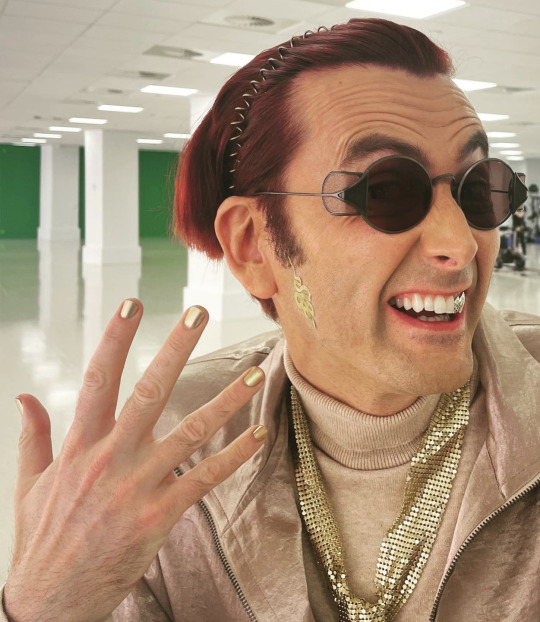

(@Princess-Spock: Genderfluidity is very complicated. Even when Crowley "looked" female, he might have been experiencing a variety of different genders; remember, neither genitals nor presentation determine gender! In fact, since Crowley had adopted a female appearance out of necessity, not because that was his true gender at that time, he might even never have actually BEEN female during the time he was "looking" female!)
What about Aziraphale? He has all the “male stuff” that Crowley does (facial and chest hair, deep voice, etc). He has an unwaveringly masculine presentation; his hair is ALWAYS short throughout history (even when Gabriel’s is long), and his sartorial choices are traditionally and formally male (pocket watch on a chain, French cuffs with cufflinks), with no hint of the modern androgyny of jeans and T-shirts… strong evidence that his chosen gender is male.
Neil always refers to Aziraphale and Crowley as he/him (he stated that Crowley was presenting female as Nanny Ashtoreth and at the crucifixion, but no pronoun is used either time). The book and the script book always refer to Aziraphale and Crowley as he/him. Aziraphale and Crowley always refer to each other as he/him. Michael and David have always referred to Aziraphale and Crowley as he/him. So, he/him is our personal choice.
What about the pronouns of other supernatural characters?
Beelzebub:
He/him in the book. She/her in the script book. For S1, Neil said, “I don’t think there were any. Probably Zzzzzzir.” They/them for S2 (“but they're always such a little ray of sunshine” in E3).
Dagon:
In the book, no pronouns are used, but all male titles; Lord, Master, Under-Duke. He/him in the script book. No pronouns used in the show or by Neil.
Muriel:
They/them canonically, but referred to by Quelin Sepulveda, the actress who plays Muriel, as she/they. It seems like the gender perception of the actor who embodies a character has to count for something; if Quelin was perceiving Muriel as partly female, that's an intrinsic part of who Muriel IS. We think we should honor that. (Neil has had plenty of opportunity to debate Quelin's usage, but never has.)
(Food for thought: If we accept this sort of "mixed" pronoun usage as valid in the Good Omens universe, it could apply to other angels or demons, not just to Muriel!)
Archangels played by actresses:
In the script book, when Aziraphale speaks to the 4 archangels, it says; “The room of angels in slick suits. There are four of them, male and female.” It doesn't specify WHO is female, though, and ALL the archangels have non-female pronouns elsewhere in the book, so...?
Uriel:
"He" in the script book, no pronouns otherwise.
Michael:
“He” in the script book. Neil has used "they."
Angels and demons played by male actors:
All of them are referred to with male pronouns, both within the series and by Neil. However:
Hastur:
Briefly had a female appearance in the scene where Aziraphale and Crowley are kidnapped, but no pronouns were used at the time. In the script book, the “lady tourist” is referred to as "she" when whacking Crowley… and then is referred to as "her" even AFTER transforming into Hastur with a wig.
Ligur:
In the book, Ligur was intriguingly referred to as “it” while he was dying, but immediately thereafter was referred to as "he." That paragraph appears almost word for word in the script book; it refers to him as "he" instead of "it."
Sandalphon:
Referred to in the script book as "it." (“Sandalphon grins, pleased with itself. Then it sniffs the air.”)
Metatron:
"He" in the book and season 2.
God:
Neil said: Jesus uses "Father". Aziraphale uses "She" pronouns for God and Crowley uses "They". I don't think the God in the Good Omens TV universe has a gender.
In the book, Aziraphale, Crowley and Metatron refer to God as He. In the script book, Aziraphale refers to God as She, and Crowley refers to God as They and She.
We think the bottom line is: These are FICTIONAL characters inhabiting a universe where there are few canonical rules for pronouns or gender for supernatural beings. This is a perfect vehicle for choice, which has so much importance to the story. You may start out on opposite sides, you may start out as a genderless being, you may start out as a sexless being, but you can choose something different for yourself. The importance of choice in Good Omens is one of the things that makes it great!
There’s a lot of fic and art that depicts the characters in different ways; everyone should feel comfortable portraying them the way they choose without the worry that someone is going to be upset with them. We’ve both seen a lot of comments to the tune of, “you’re not using the correct pronouns” or “that’s not the correct sexual orientation,” and that’s not good fandom etiquette. Being open-minded and kind to one another as we flesh out this universe for ourselves is just basic courtesy. Neil himself has said that in fandom, any interpretation is valid! The Good Omens fandom is largely a microcosm of the queer community; we need to practice acceptance amongst ourselves, so that we can stand together against those in the wider world who want to tear us down!
Anyone who wants to discuss personal gender issues can feel free to message @Princess-Spock; remember that if you ask anonymously, there's no way to reply to you!
#GoodOmens#GOS2#Crowley#Aziraphale#NeilGaiman#IneffableGender#IneffablePronouns#GoodOmensGender#GoodOmensPronouns#GoodOmensMeta#GoodOmensSeason2
170 notes
·
View notes
Note
bro if u have a beard u can't be androgynous that's the thing lmao. androgynous looks imply that u can easily be mistaken for a guy or a girl... so of u have a beard then that kind of cancels it out
nobody is saying that being androgynous is only for the "soft butch elven twink" dynamic u mentioned. if u posted some examples of what exactly u meant then maybe 4k people who liked ur post would understand exactly what ur talking abt

also:
androgynous, adjective: not clearly male or female, or having both male and female features
neither clearly masculine nor clearly feminine in appearance, or having an ambiguous sexual identity or having both masculine and feminine gender characteristics.
having the characteristics or nature of both male and female
196 notes
·
View notes
Text
Hello everyone! First post; I'm a bit nervous... I hope you're doing well!
I still don't have a clear idea of what exactly I could do with this blog, but there is one thing I'd like to share: it has to do with the Genderfluid Fragment Gender System (GDGS), a system of terms that specify what range of genders one is fluid between, and the issue of underrepresentation of androgynous genders in some of these.
(For extra clarity, androgyny refers to a state of being both masculine and feminine, as opposed to gender-neutrality, which means neither masculine nor feminine, although the two are often used interchangeably, hence the lack of regard for the distinction.)
For those who are here to learn, the main terms in the GFGS are:
genderfae (being fluid only between female, feminine and neutral genders, never a masculine gender);
genderfaun (male, masculine and neutral, never feminine);
genderflor (only neutral, never masculine or feminine).
By adding suffixes to these, you can extend the range of them a bit:
genderfaer (female, feminine, neutral, and partially masculine genders but never binary male);
genderfaunet (male, masculine, neutral, and partially feminine but never binary female);
genderflorer (neutral and partially masculine, but never binary male or feminine);
genderfloret (neutral and partially feminine, but never binary female or masculine);
genderfloren (neutral, partially masculine, and partially feminine, but never binary male or binary female).
There's also the genderfrith root and its variations, for people who always feel a connection to masculinity or femininity:
genderfrith (fluid between any masculine and/or feminine genders, binary or not, but never neutral);
genderfrither (binary female, feminine, masculine, never binary male or neutral);
genderfrithet (binary male, masculine, feminine, never binary female or neutral);
genderfrithen (partially masculine and partially feminine, never binary female, binary male, or neutral).
Finally, if you're fluid between all genders, that's called genderfruct.
In short, at the beginning of my gender discovery, I thought I was fluid only between a state of gender neutrality and one of androgyny, and I was surprised to see no term amongst so many of these to refer to said experience!
I looked to genderflor, but it does not, by definition, include genders that are in any way related to femininity or masculinity, so by extension androgyny. So how do you refer to that?
I felt like the system was a bit incomplete. So! I decided to take initiative and COIN new genders that extend the possible range of the main GFGS terms!
The actual names for the first 3 were coined by the blog @neopronouns, since I did not have enough creativity with words—I only had the flags already in mind. He just added a suffix to the genders, "-an", which is short for androgynous in this case. Genius!
So, I present to you...
Genderfaean (for pronunciation, a tip is to keep in mind that the root word is "fae", then you just add "an"): being fluid only between neutral genders and any gender that is feminine in some way—including when it is in combination with masculine, therefore androgynous. Masculinity can never be experienced on its own. (Example: fluid between girl, non-binary girl, agender, androgyne).


Flag is the first, on the left; I put the genderfae flag to the right for comparison. The pink gradient stands for femininity, and I replaced the green-to-yellow gradient (which stood for neutrality) with a purple-to-yellow gradient, representing neutrality (yellow) and androgyny (purple, which I colorpicked from the non-binary flag).
Genderfaunan: being fluid only between neutral genders and any gender which is masculine in some way—including when it is in combination with feminine, therefore androgynous. Femininity can never be experienced on its own. (Example: fluid between boy, demiboy, neutrois, boygirl)
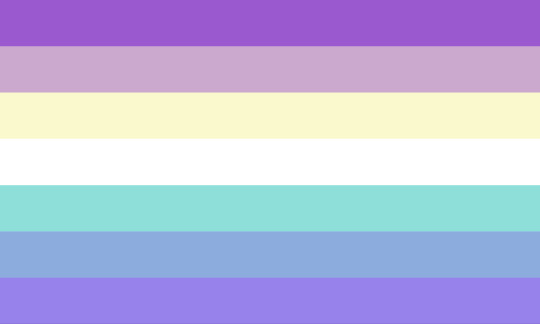

Genderfaun flag on the right for comparison. The blue gradient at the bottom stands for masculinity; again I replaced the orange-to-yellow gradient (which stood for neutrality) with a purple-to-yellow gradient.
Genderfloran: being fluid only between neutral genders and androgynous genders, never solely masculine or feminine genders. (Example: fluid between neutrois and androgyne)
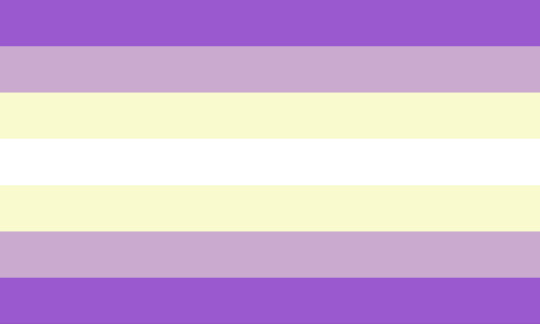

Genderflor flag on the right for comparison; I replaced the green/orange-to-yellow gradients with purple-to-yellow ones (it's symmetrical).
Coining these next two terms myself:
Genderfloretan: being fluid only between neutral, androgynous, and partially feminine genders—never binary female or male. Can experience masculinity, but only in combination with femininity. (Example: fluid between neutrois, boygirl, demigirl).


Genderfloret flag on the right for comparison. The darker orange stripes in both flags represent partial femininity. Replaced green-to-yellow with purple-to-yellow.
Genderfloreran: being fluid only between neutral, androgynous, and partially masculine genders—never binary male or female. Can experience femininity, but only in combination with masculinity. (Example: fluid between agender, androgyne, non-binary boy).


Genderflorer flag on the right for comparison. The darker green stripes in both flags represent partial masculinity. Replaced orange-to-yellow with purple-to-yellow.
All the other genders of the GFGS I didn't extend like this already included the possibility of experiencing androgynous genders (e.g. genderfaer: female, feminine, neutral, and partially masculine, so this means this partial masculinity can also be experienced in combination with femininity).
That's it! Thanks for reading this through! Hopefully someone will find these useful :) [smiley]
#gender coining#new gender#flag coining#genderfaean#genderfaunan#genderfloran#genderfloreran#genderfloretan#genderfluid fragment system#genderfluid fragment gender system#genderfluid#androgynous#genderfae#genderfaun#genderflor#genderflorer#genderfloret#genderfloren#genderfaer#genderfaunet#genderfrith#genderfrither#genderfrithet#genderfrithen#genderfruct#gender identity#gender#trans#nonbinary#lgbtqia+
195 notes
·
View notes
Text
Panel Presentation: Stranger Things

"Stranger Things" is a popular science fiction horror series created by the Duffer Brothers. Set in the 1980s in the fictional town of Hawkins, Indiana, the series combines supernatural elements with a nostalgic nod to '80s pop culture.The story revolves around a group of kids, who encounter a mysterious girl with psychokinetic abilities who goes by the name "Eleven." The group soon discovers the existence of an alternate dimension known as the Upside Down, which is inhabited by a monstrous creature known as the Demogorgon. Throughout the series, they also receive help from various adults. The show has multiple seasons, each building on the mysteries and challenges faced by the characters as they confront the strange and terrifying forces that invade their small town.
What concepts of Gothic doubling function to define the natural from the supernatural?
Whether it be the concept of “Gothic doubling” ( the divided personality of a character) or the concept of the “uncanny double”, as described in “Postfeminism and the Supernatural in Penny Dreadful” as “ a dark force inside her that makes her commit unspeakable acts. Such force could be interpreted as her uncanny double, who, according to Saxey, ‘is typically a splitting of the hero,’ and whilst ‘[o]ne aspect [...] remains socially respectable, the other commits (or urges) terrible acts’ (2010: 67)”, there are many examples of “doubling” in Stranger things. For example, the gothic doubling of Will Byers and the Shadow Monster or (Mind Flayer). In the second season, Will Byers, a normal kid, becomes connected to the Shadow Monster, a malevolent entity from the Upside Down (a parallel dimension that is a dark, eerie, and dangerous mirror image of the real world). This connection creates a doppelganger effect, as Will's body is used as a host for the monster, and he is forced to serve its sinister purposes. This relates to the quote from the reading “ neo-Gothic fiction portrays an insidious Other that can neither be contained nor controlled.” It shows the concept of doubling as a supernatural evil force that takes control of natural bodies.
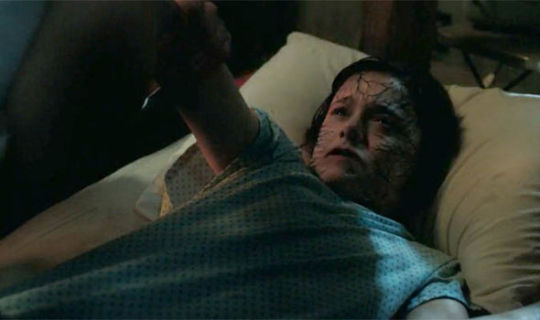
In what ways is gender performativity tied to the supernatural?
The character of Eleven in Stranger Things possesses supernatural psychokinetic abilities . She appears to the viewer in Season One as a blank slate, free of individuality, gender, or identity after she had escaped from a secret government lab. The idea of gender performativity is that “being born male or female does not determine behavior. Instead, people learn to behave in particular ways to fit into society. The idea of gender is an act, or performance.”Throughout the series, we see Eleven as both vulnerable and strong, damaged and super-powered, androgynous and feminine. She is hard and soft, in other words boyish and girlish, as determined by stereotypical notions of gender. All of these characteristics are quite literally embodied in her physical appearance, especially in her hair and clothing. Eleven’s hair, clothing and cosmetics are a sequence of physical identities that show how others decide to view her or enforce their own perspective onto her. In Season 1, Episode 4, the boys set out to dress Eleven according to what they expect a girl to look like. By making Eleven into a “pretty” girl, the boys have remade her as a person who fits the conventionally accepted elements of appearance for a young girl, who is delicate and weak. Various styles and appearances are placed upon Eleven, but she doesn't determine or explain her own self-perception, this underscores the idea that gender expression and how one presents themselves are performative acts.
youtube

Aside from Eleven dressing feminine, whether she decides her own wardrobe or not, I think that being supernatural in general, and having strong powers, can often make these characters fit into a more masculine role, or obscure the gender binary.
How does the series use the supernatural to liberate characters from oppressive normalcy?
Amongst using her powers to fight bullies and supernatural monsters,t hroughout the seasons of Stranger Things, Eleven uses her powers to fight against Hawkins National Laboratory. Hawkins National Laboratory is a lab that experimented on her and other child test subjects, and who continuously try to capture her. Season one episode 7 is an example: when the doctor and lab threaten her and her friends, she uses her powers to flip a van, providing a dramatic escape and resisting the oppressive forces pursuing her.
https://www.youtube.com/watch?v=aTjmiwXRyXs (1 min 30 seconds in)

In what ways do Gothic doubles allow characters to transgress scripted gender that society imposes on them?
Another example of a gothic double in Stranger Things is when the Mind Flayer targets Billy and uses him as a vessel to once again carry out its sinister plans in the real world. In order to break free from the Mind Flayer, Billy has to simultaneously break free from scripted gender norms for men. In the scene where Billy sacrifices himself to the Demogorgon, he subverts the stereotypical tough and unfeeling demeanor associated with toxic masculinity. Instead, he displays vulnerability, empathy, and a willingness to protect others, challenging the conventional narrative of his character and, by extension, prevailing gender norms. The article assigned states “ Furthermore, in most neo-Victorian Gothic retellings, Freud’s uncanny ([1919] 2001) is revisited to explore the characters’ repressed traumas”. Throughout the series, glimpses of Billy's troubled past are revealed, illustrating the impact of an abusive father and the expectations placed on him. The supernatural elements surrounding his character force him to confront these traumas, as seen when Billy's facing of his past traumas allows him to break free from the Mind Flayer.
youtube
One more example: Eleven has a powerful counterpart or “sister” named Kali. Kali possesses psychic abilities similar to Eleven and acts as a sort of dark mirror to her. While Eleven represents good and empathy, Kali has a darker, more vengeful side. Kali encourages Eleven to embrace her anger and use her powers without restraint, challenging the conventional expectations of how a girl, especially one with supernatural abilities, should behave. Although, ultimately, trying to teach people to kill isn't good, she does teach her to use her power in stronger ways and shows her that her powers shouldnt be suppressed. She also gave Eleven a new hairstyle and put dark makeup on her, subverting the traditional feminine gender roles imposed on women.
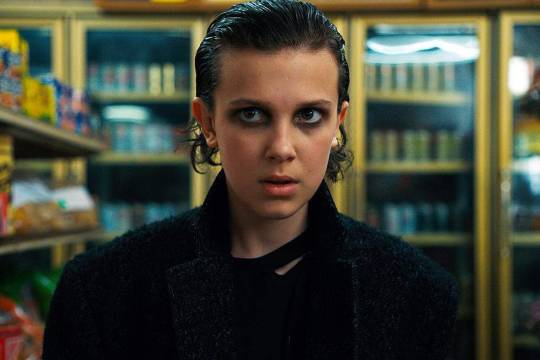
.
How are characters rewarded or punished for subverting their expected character traits?
Characters who subvert their expected traits often undergo significant personal growth. For instance, Steve Harrington starts as a stereotypical high school "bad boy" but evolves into a more caring , responsible, and protective individual over the seasons. Although the growth is a reward in itself, Steve also makes genuine friendships, such as Robin Buckley. Instead of pursuing a romantic interest, he enjoys their platonic friendship. Also, he becomes an unexpected mentor to the character Dustin. He imparts valuable advice on dating, self-confidence, and helps in moments of danger. Another example is Nancy Byers. She challenges gender norms by pursuing a career in journalism. Despite facing skepticism from her colleagues due to her gender, she perseveres and works hard to prove herself. Eventually, she uncovers important truths about the supernatural occurrences in Hawkins. Her actions and discoveries have a positive impact on the group's efforts to understand and combat the threats from the Upside Down. Nancy’s character shows the reward of personal success that can come from subverting expected character or gender roles and prioritizing personal values over societal expectations.
Questions:
The article states “Whilst madness and supernatural possession might allow female characters to speak up against patriarchy and gender oppression, their criticism is usually undermined by other characters in the series, and society in general, as the ramblings of a madwoman.” Do you think that women who have supernatural powers compared to men are seen to be more “hysterical” or a dangerous ‘Other’ that cannot be controlled?
How do you believe individuals with supernatural abilities who perceive themselves as "monsters" are influenced by this characterization of themselves? Or how do other people considering them to be “monsters” affect them?
Do you think your tv shows characters are successful in using their supernatural abilities to subvert or create an agency over whatever type of oppression they face?
14 notes
·
View notes
Text
My confusing gender-journey (I'm still confused lol)
I came out last year as genderfluid because I was really unsure about how I was feeling with my gender and allowing myself to be and feel everything was at first very liberating. But, a part of me knew that it was not who I really was. I just had to verbalize the confusion I was experiencing and coming out as such helped me a lot.
I started saying I'm genderqueer/non-binary for the past few months since I don't find myself in any other more specific label. I'm just living my life knowing I'm not a male nor a female and never be, making me someone not really genderfluid or a least, not in the conventional way. I don't know if it's enough but right now, these labels fit me. At the same time, I don't care about my gender bus I also don't feel like I don't have one and I do care not being viewed as a man or a woman.
I just looked at my reflection in the mirror and saw myself as a guy and liking it and this has happened to me like 3 times before ??? Maybe it's the fact that i don't look like a female that's giving me gender euphoria maybe ? Like it's proving me that I can look more androgynous? Gender can be so confusing... but this feeling was gold, as much as when i started to see myself as nb.
So yeah, I'm genderqueer and have seen myself for the past month as really in the middle or totally outside of the male/female spectrum. Feeling good looking more boyish is really validating to me, 'cause that proves me that being a female is not the right option for me (and it also does not make me a men neither).
So, darling, if you're having a hard time finding the right label for you, just know that sometimes, you gotta make your own rules.
Most of all, you're not alone and needing time to figure out who you are is ok and normal. Take the time you need, no need to rush
#gender identity#agender#nonbinary#gender nonconforming#enby#genderqueer#queer#gender journey#identityjourney
3 notes
·
View notes
Text
Interesting™ Things I Did as a Child
Age 5: Wanting to take off my shirt like Jeff Goldblum in Jurassic Park because he just looked cool to me
Age 6: Telling my mom that if I ever got rid of my long hair, I’d want to have a “boy’s haircut.” I was then told not to do that because people might think I was a lesbian.
Age 7: My mom changed the channel because two teenagers were kissing in a coming-of-age movie. I thought they were both girls and didn’t see why it was so inappropriate for friends to kiss each other, because I kissed my friends sometimes. Apparently it was a boy and a girl; but I wanted them to be two girls.
Age 8: My teacher remarking that I was the only girl she’s ever seen draw herself as a football player for the professional sports assignment.
Ages 6–10: Tucking all of my hair under one of my dad’s baseball caps, wearing baggy clothes, and a football necklace so I’d look like a boy.
Ages 8–10: Only playing with the boys at recess to the point where everyone thought I had a crush on one of them (but I didn’t).
Ages 7–11: Getting really insulted if anyone ever called me a “girly girl” just because I wore pretty clothes.
Age 12: Attempting to draw the “perfect biological ideal of someone who is neither male nor female” and overall having a lot of androgynous, genderless, intersex, and GNC characters in my works way before mentally undoing my internalized homophobia and everything else.
Age 13: Seeking out androgynous clothing so I would look neither male nor female.
Age 14: Disliking the way my clothes fit, even though they technically fit me perfectly.
Ages 10 — 15: Being obsessed with Data and wanting to look like him.
Ages 15 — 16: Watching a lot of femme-leaning male makeup artists on YT and going “huh I kind of act like them.”
Age 17: Being disturbed that most of my role models are men.
5 notes
·
View notes
Text
Real women?
Celestial put out a series of video clips revealing that there might be more transgender celebrities than one realises, though not necessarily delivered in the way you think it is because God told her to reveal their deception to people. If we Christians are to believe in the mantra that trans women are women and trans men are men, despite both being born to the contrary, then we might be buying into their lies or delusions.
I think intersex individuals are largely exempt, especially when it comes to androgen insensitivity syndrome, where they turned out this way due to a genetic mutation. Like if you have complete or severe AIS, it's not your fault why you turned out to be female despite being genetically male is really due to a faulty mutation, that's different from transgender which involves willfully becoming the opposite gender or something like that.
There's nothing deceptive about being androgen insensitive, especially if it's really severe, that it's something you ended up with, not something you're fighting against. No different from albinism where you ended up with a serious pallor and vision problems, or dwarfism where you're shorter than average. (I actually listen to videos by a black pastor with albinism by the way.) Whereas with being transgender, there's an air to deceptiveness to it if God intended men to be men and women to be women.
To be honest, I had gender dysphoria before where I wanted to be a boy because I didn't like what I was turning into and was kind of androgynous for a while. Eventually I kind of outgrew it and turned out to have a liking for feminine clothing and floral prints, strange how that worked out. I feel for a number of transgender people, they want to become the opposite sex because they too didn't like what they felt like they turned into so surgery and the like are their ways of undoing it.
But even then they're still going against what God intended them to be, like they want to follow their own wills instead of submitting to the will of God, which is something I myself have struggled with but with other things that got me into a lot of trouble. At other times, the other facets to transgender identities are just as baffling and nonsensical. My father said that this genderfluid thing is like somebody stealing something because they like it or whatever he's trying to convey.
To be genderfluid is to flit with various gender identities over time, though only superficially if God intended men to be men and women to be women. You could say that intersex is a kind of exemption to this, but then again God made some people intersex and even then people with serious AIS see themselves as female from the get-go due to how they ended up as. (You could say I'm wrong here when it comes to other intersex conditions.) Transgender is something else altogether.
Somebody who is transgender are practically deluding themselves to be somebody that they're not, even if it's something they felt like they have to settle scores with in some way when it comes to what they ended up as upon puberty. It's hard for me to see somebody as nonbinary (being neither male nor female) if they're either clearly female or clearly male, like if you have a really feminine figure it's going to be hard trying to pass yourself off as being neither male nor female.
I still see Sam Smith as male because that's who he really is, he's just a fat gay man who had the audacity to dress up as the Devil. So logically somebody like Laith Ashley is still female, despite their attempts to live as a man as much as possible that one day they'll come out in the media as seeking menstrual pads because they're menstruating. Unless if somebody's seriously androgen insensitive, it's a clear indicator that they're still female to God.
Ashley looks convincingly male but if they start getting impregnated by somebody like a sperm donor because they can't father a child to their girlfriend, then they can't entirely betray who God intended them to be: a woman. A transgender individual can only do so much to undo what they like what's been done to them, since they can't completely betray the gender they were born as. While Celestial's video clips address trans women, it can also be applied to trans men.
But the odd fact that some of these female sex symbols are in fact men makes one wonder if women are inevitably set up against something they could never be, especially when it comes to how women's bodies typically store not only more body fat than men but also more body fat in places like thighs, hips and buttocks that the perfectly slim, toned legs is something that could never be attainable for women.
I remember this website called Feminine Beauty which says that a good number of female fashion models are rather unfeminine looking, one might wonder if this is close to what Celestial's been saying. If this is true, then this explains a lot of things in ways we don't realise nor expect.
0 notes
Text
What is non-binary gender? – A Complete Guide
You may have heard some new phrases floating round to explain Gender or sexuality that you are unexpected with, and that is completely okay. As our expertise of sexuality and Gender definition expands, so, too, does our vocabulary that describes those individuals. Instead of getting pissed off that you are out of the loop or do not completely understand each new time period right away, do not forget this: The international is not suddenly special, however our expertise of it keeps to broaden, that may only be an awesome thing.

What is non binary Gender? If you have heard the time period non-Binary and puzzled what its method, you are not alone. First, it allows to apprehend the time period binary, meaning a coupling of special things. If you are thinking about this in phrases of the ancient category of Gender, the Gender binary consists of male and girl. When you use the time period non-Binary, you are asserting that there are greater than definitions of a single thing, on this case, Gender.
Non-Binary method current or figuring out outside the sex/Gender binary, neither guy nor woman, or being partly or a combination of those things
What Else Can Nonbinary Mean?
Some people use the time period to explain their Gender expression rather than their Gender identification, in step with GLAAD, an employer that works in the direction of greater reputation of the LGBTQ community. Gender expression refers to the methods you outwardly deliver Gender through things like your clothes, haircut, voice, or behavior.
Other people say they are “nonbinary” to expose they are opposed to the concept of there being constant Gender roles.
How Are Transgender and Nonbinary People Different?
Most transgender people perceive as being male or girl, and that they do not forget themselves nonbinary, the National Center for Transgender Equality says.
Is There a Certain Way to ‘Look’ Nonbinary?
Some nonbinary people dress, talk, or deliver themselves in conventionally masculine or female methods. Others specific themselves in greater androgynous methods, which means with each girl and male traits.
Some nonbinary people pick out to get surgeries or hormones to medically transition their bodies. Those who bodily transition might also additionally nonetheless perceive as nonbinary humans, though. If you want to know more about reproductive rights vs Reproductive justice, consider visiting our official website.
0 notes
Text
I like snooty elves. Snooty elves who are assholes and are just above everyone are funny to me.
BUT.
What I love MORE is snooty elves who are also very supportive. Give me snooty elves who stick their nose up at everyone else but, when they are with their friends they turn around and go into full supportive wine aunt energy. Like, they won’t give a fuck if someone was being made fun of on the street but, the minute you make fun of THEIR friend. Ooo boy, they will bring hell upon them. Also they make supportive lgbtq+ friends.
With how androgynous elves are they can give good fashion advice and just be supportive.
Human: “I don’t know if I feel like a girl or a guy..”
Elf: “That’s fine.”
Human: “You’re not going to make any snarky remark?”
Elf: “No, Look at me. I blend through those lines every day human. I neither male nor female. I am me. I choose what I want to be.”
Human: “Oh. Guess you’re lucky.”
Elf: “No, No, Do not act like that. Come human. I will show you my ways. I want you to feel comfortable in your own skin. You are my friend and you will show off what YOU want to be.”
#urban fantasy#urban magic#suburban fantasy#fantasy#fantasy world#my writing#fantasy writing#writeblr#writers#writers on tumblr#fantastical#Modern Magic#modern fantasy#Modern Monsters#modern au#elves#elf#High elf#fantasy high
58 notes
·
View notes
Note
Let's go with male body image issues. Tw: eating disorders
First all body standards and body image issues suck.
Like I presented female for the first 20 years of my life, and I used to get bullied for being too skinny but also for not being skinny enough bc I didn't have a flat stomach. I never weighed enough to be considered slim thick either.
Flash forward senior year of high school where I legit ate maybe a medium Chilli cheese fry and a small (4 pc) mozzarella stick every day for a couple of months bc I was tired of being fat.
By time I came out as a trans man, I started watching videos about trans men being these super buff or toned men which I straight up wasn't bc I'm naturally a stick and lost 8 lbs to testosterone. Guess who still didn't have a flat stomach.
I could either be the small cute uwu flat stomach version or the chiseled, super muscular version. I wasn't allowed to be something else.
Then I jumped head first into body positivity for men. We need to show more love to men who have bellies that stick out and love handles and stretch marks.
I'm none of the above, so I told myself I'd be the skinniest i.e. seen as twink bc I'm mostly gay version of myself. I started cutting how much I ate and trying to run as much as I could when I wasn't super depressed and had the energy to do so.
But wait there's more. Skinny guys are seen as undesirable and effeminate which isn't great for a transmasc/androgynous man like myself.
Men like women don't get to look like themselves. Can we stop normalizing types of bodies instead of bodies being bodies and how they're not all the same. We're not allowed to be ourselves but supposed to be "healthy" and positive.
Eating next to nothing and trying not to pass out if you exercise or move too much is not healthy. Spending hours at the gym multiple times a week is not healthy. Striving to be one of the two is not healthy. Our bodies are not healthy if we keep trying to reach standards that are beyond our control.
Can men grow to love themselves if we're shamed for being skinny bc we're small and weak, for being slightly muscular bc we're not trying hard enough, for being super buff bc we're toxic and misogynistic, for being too fat bc we're lazy "nice guys", and for being none of the above bc we don't belong to an extreme?
No one wins. Neither men nor women nor anyone in between.
Really appreciate you sharing your story friend.
Amen awomen /ref to all the above
6 notes
·
View notes
Text
Royal Guard Nomenclature
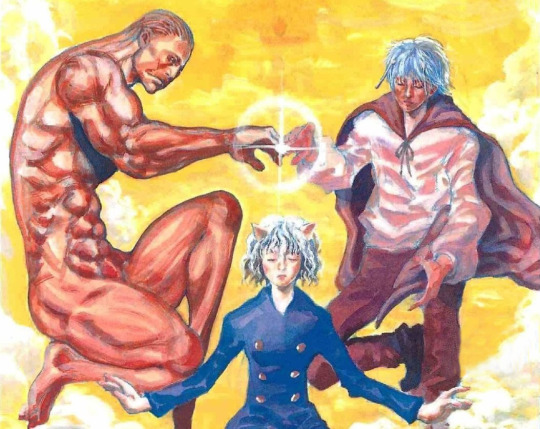
You might know the Royal Guards for having some creative names, and if you’re anything like me, you’ve probably read HxH Wiki trivia on where the names came from. However, I haven’t seen any comprehensive post getting right into it, so lets have some fun research time and look into the origins of the Chimera Ant Royal Guard’s namesakes and how they might have affected Togashi’s characterizations of them!
While i’m trying to keep everything as brief as I can, this will be a longer post so if you want to gain some knowledge and kill some time, read on! I’ve linked sources throughout the post for further research!
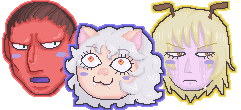
Naming Origin Sources
All three of the Guard’s names - Neferpitou, Shaiapouf, and Menthuthuyoupi, respectively- were chosen by the Chimera Ant Queen prior to their birth in the story. They are mashups from two sources - Ancient Egyptian mythology, specifically the pantheon of traditional gods and goddesses, and a French children’s book series entitled Caroline et ses amis (Caroline and her Friends) written by Pierre Probst.
The Guard x Egyptian Gods

In Ancient Egyptian life, people worshiped a large number of deities which represented natural forces and phenomena (sunlight, life, childbirth, etc). The people regularly offered sacrifices and performed rituals to please the gods so that these forces would continue to function according to divine order (ma’at). Each god or goddess had complex relationships, characteristics, and symbolism associated with them. {x}
Neferpitou x Nefertem
The first half of Neferpitou’s name, “Nefer-”, is derived from the Egyptian deity Nefertem. A very ancient god by Egyptian mythos standards, this god is associated with the lotus flower, as he was believed to have emerged in a water lily from the primal waters at the creation of the world. He also represented the first sunlight and the lovely smell of the Egyptian blue lotus. Nefertem is usually depicted as a young, beautiful man, and sports titles such as “He Who Is Beautiful” and “Water Lily of the Sun”. {x} {x}
In HxH, Neferpitou is the first Royal Guard to be born, which ties in nicely to Nefertem’s being a very early god born from the creation of the world as well as being associated with the first sunlight. As for the beauty aspect, Neferpitou’s androgynous appearance could play into this factor, as some gods in the Egyptian creation myths were depicted as androgynous.
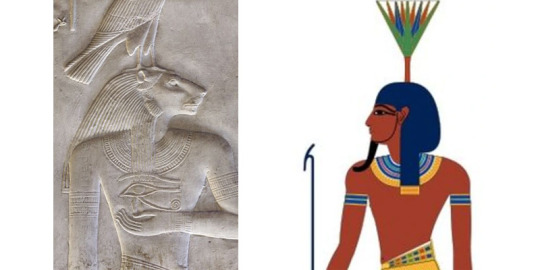
Nefertem’’s mother is often credited as being Bast/Bastet, the guardian goddess of cats, or Sekhmet, the warrior goddess of healing (both goddesses are often considered to be two aspects of the same goddess). These goddesses are both depicted with cat or lioness heads, and so Nefertem is often depicted with a lion’s head or as a lion. I needn’t say more about this tie to Neferpitou! Aside from the cat aspect, Sekhmet’s being a goddess that both goes to war and heals is reflected in Pitou’s dual nature- both a ruthless killing machine in their own right and with their Terpsichora ability making instant armies, and a reliable healer using the Doctor Blythe ability, showcasing a compassionate side. {x} {x}
Shaiapouf x Shai
Shaiapouf’s Egyptian name component comes from Shai, which, interestingly, is not so much an entity as it is a concept- the deification of the concept of Fate. The name Shai is usually translated as “that which is ordained”. This god was said to determine the span of each person’s life; he was with each person at their birth and remained with them through their life until their final judgement in the underworld (duat). Shai would offer the true life story of the individual at their judgement, and could either protect or damn them. This deity has so much power in the Egyptian mythos that even pharaohs and other gods were subject to it. {x} {x}
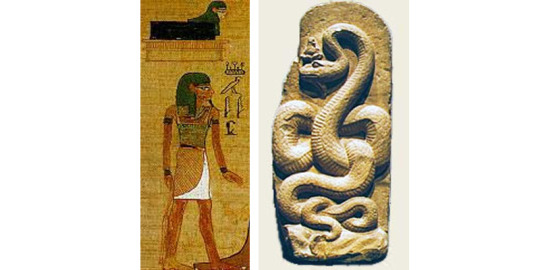
Now, although Shaiapouf as a character doesn’t have an omnipotent power over fate, the concept of fate runs really strong in Pouf’s characterization. Pouf, along with the other Royal Guards, was present at King Meruem’s birth, and intended to stay at his side throughout his whole life, guiding and protecting him. This is a role that Pouf seemed to take to heart, almost to an extreme. As we know, Pouf saw the King’s destiny of becoming the ruler of the world and dominating all other species as being absolute, and began to actively work against the Guard and even the King himself when he began to stray from the fate that Pouf had “preordained” for him. Going so far as to attempt to kill Komugi, who was the most important person to the King, Pouf’s actions, although out of a motivation to protect the King, would have been damning for the King had he succeeded.
Shaiapouf’s nen ability, Spiritual Message, gives us a hint as to his namesake as well. The god Shai hid nothing from Osiris (god of the underworld) at the final judgement of that person’s life, and so does Pouf’s ability allow him to see the absolute truth about a person’s emotional state by reading their flow of aura. This gives Pouf the ability to come to conclusions about that person’s personality, thoughts, and possible course of action, seemingly allowing him to predict their “fate”. {x}
Also, this may be a trivial fact, but Pouf has the habit of ending his sentences with, “That’s all there is to it”. A very final and fateful statement indeed.
Being a concept, Shai is neither male nor female, but is more often depicted as being male. In this form, he is often said to be married to Renenutet (cobra goddess of child rearing who gave newborn babies secret names), or Meskhenet (goddess of childbirth). These three are often depicted together which gives us a definite picture of the cycle of birth and death. {x} {x}
In HxH, after Meruem is mortally wounded by the Miniature Rose Bomb, we get the lovely and terrifying experience of seeing Pouf and Youpi feed themselves to the King in order to revive him. In this scene, both guards are ecstatic as they have ascended to the level of a Chimera Ant Queen and are filled with an unconditional motherly love for their King. The ties here between this occurrence and these trifecta of gods associated with birth and life are pretty strong.
A few final small factoids: The Greek people associated Shai with their god Agathodaemon, a god of fortunetelling that was considered to be a serpent. As well, the word Shai was also an Egyptian word for “Pig”. Thus, Shai was sometimes depicted as a serpent-headed pig, also called the Shai animal. I am reminded of the time Pouf was shown to be able to rearrange his cells to impersonate a certain blind Gungi player.
Menthuthuyoupi x Montu
The final Royal Guard, Menthuthuyoupi, bears the name of Montu, a very powerful and ancient god in the Egyptian pantheon. Montu (also written as Monthu or Menthu, the latter which Youpi uses in his name) originally was a manifestation of the scorching effects of the sun (Ra), but over time this was modified to mean destructiveness in battle, which led to Montu being known as a god of war. He was said to attack the enemies of cosmic order (ma’at).Montu is usually depicted with a falcon head or a bull head. Falcons were a symbol of the sky, and bulls symbolized strength and war. {x} {x}

Montu was often linked with other gods and is depicted as a fusion of those gods. For instance, because of his association with Ra, he often appears as Montu-Ra. Occassionally he is linked to Atum (another creator god) and Set (god of scary natural phenomena and deserts). Over time, Montu was also linked to Horus, a god associated with the pharaoh, and therefore Montu is sometimes seen as being a symbol of a Pharaoh as a ruler and conqueror.
In HxH, Menthuthuyoupi definitely embodies the warlike aspect of his namesake. Being the only guard not made from human genetic material, he is able to act on instinct and devote himself completely to being a soldier for the King, attacking anyone who threatened the King’s divine rule. Being immensely powerful, Youpi was capable of immense damage with his Rage Blast and Rage Incarnate nen abilities. As well, just as Montu gradually evolved over time to represent more complex aspects of life in Ancient Egypt, so too did Youpi evolve over the course of the Chimera Ant Arc, which gave his life new and more complex meaning.
The many forms Montu can take reminds us of Youpi’s unique Metamorphosis ability, which allows him to change any part of his body at will to suit his needs. Youpi’s Rage Incarnate form, in which his body takes the worm of a winged centaur, is a callback to Montu’s two most common depictions; as a Falcon (Youpi’s wings), and as a Bull (Youpi’s hooves). {x}
One of Montu’s wives was thought to be Tjenenet, another goddess of childbirth, which has ties to the event of Meruem’s rebirth discussed in Shaiapouf’s section above.
An interesting tidbit of info is that Montu was sometimes though to be a guardian of family life. He is sometimes mentioned in marriage documents to enforce commitment; infidelity is described as “the abomination of Montu”. While this doesn’t really have anything to do with Menthuthuyoupi aside from maybe reflecting in his loyalty to the King, the next time you feel tempted to cheat on your significant other, imagining a frowning Youpi may dissuade you.
One thing that each Royal Guard has in common with all of their Egyptian namesakes is that all strive to support what they see as the Divine Order using their individual strengths, even if their methods of supporting this order greatly differ.
The Guard x Caroline et ses amis
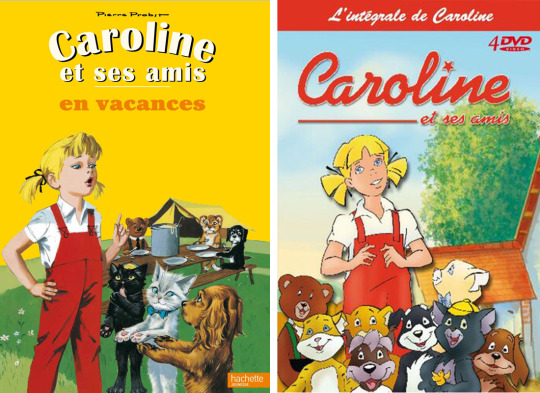
The Caroline series is a series of French childrens picture books, or albums, written and illustrated by Pierre Probst. There are 44 books in the series, which were written from 1953 to 2007. They follow Caroline, a little blond girl who is independent and active, and her 8 mischievous animal friends, who talk like humans. The series was adapted into an animated TV show titled Caroline et ses amis in 1994, which is most likely the source Togashi got the names for the Royal Guards from (and you can find on youtube!) {x} {x}
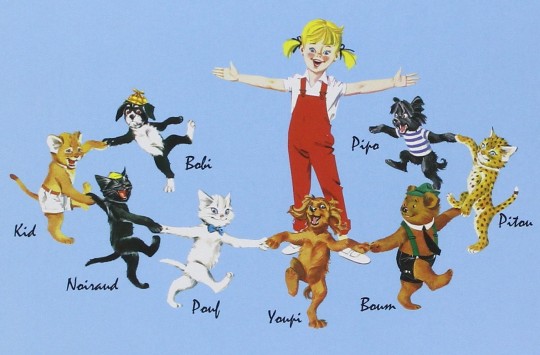
Neferpitou x Pitou
Pitou is one of the 8 animal characters in Caroline. Pitou is a panther, and he appeared in a collection called “Les Albums roses” (The Pink Albums) in 1952, which were a precursor to the Caroline books, thus making Pitou the first character of the future Caroline series. Pitou is characterized as being lazy and cunning.
In HxH, our Neferpitou was the first of the Chimera Ant Royal Guard to be born, just as Pitou was the first character that began the Caroline series. Both of them being a cat is also a very obvious connection that both share. While there are other cats in the Caroline series, Pitou being a panther harkens to Neferpitou’s wild nature. Caroline’s Pitou being both lazy and cunning are character traits that show up in HxH’s Pitou as well; we see them exhibit extreme intellect in science, military strategy and manipulation, but at the same time they are the most playful of the Guard and get distracted very easily.
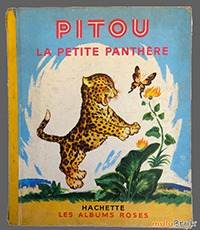
Shaiapouf x Pouf
Pouf is a white kitten that wears a blue bowtie. He is characterized as being elegant, snobbish, and eccentric. He is prone to going on rants about his dreams of greatness, much to the annoyance of everyone else, and he has little quirks such as hating water and the cold.
If it weren’t for the physical description, you might have thought I was describing HxH’s Pouf- he too is elegant, snobbish and eccentric and often goes on long, intellectual rants, which are mostly never followed by the rest of the guard. Shaiapouf is also always wearing a flowy white dress shirt that features a bowtie-like collar which is reminiscent of Pouf’s white fur and bowtie. While Shaiapouf isn’t known to hate water or cold, he does manifest peculiar quirks such as melodramatic monologues and playing his violin when he is upset.
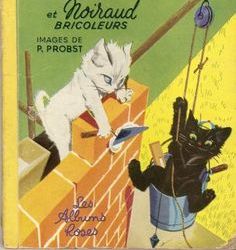
Menthuthuyoupi x Youpi
Youpi (also spelled Yupi), is a cocker spaniel dog. He is naive, turbulent, and a little bit grumpy, but also generous, devoted and affectionate. He can be fearful and prefers staying home to going out on adventure. He really likes being cuddled by Caroline, the main character.
Menthuthuyoupi in HxH displays a lot of similar characteristics to his namesake: naive, turbulent, and devoted are all adjectives you could use to describe him. Because of Menthuthuyoupi’s lack of ego, he is solely devoted to the King and his divine destiny, not bothering to give a thought to other courses of action, which could be a reflection of Caroline’s Youpi prefering to remain in the safety of home. After Meruem’s revival, when Youpi and Pouf share a affectionate spiritual bond with him, Youpi is shown to cherish the new bond he has with his King, just as Caroline’s Youpi is affectionate towards Caroline.
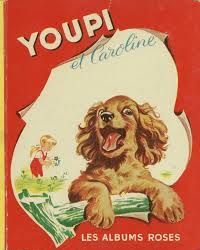
~~~
One thing that all the Royal Guard share with their Caroline namesakes is that both sets of characters unquestioningly follow an independent leader character that they love and support. As well, in the case of Neferpitou and Shaiapouf, their manner of dress is a homage to Caroline- Pouf dresses in a very elegant and frilly ensemble, very French of him, in my opinion- and Pitou’s outfit is reminicent of both an old school French military uniform and a child’s school uniform.
A bonus Caroline homage in HxH: The titular character Caroline is famously depicted with her pigtail hairstyle. A certain blind Gungi player is also famously shown sporting a similar hairstyle.
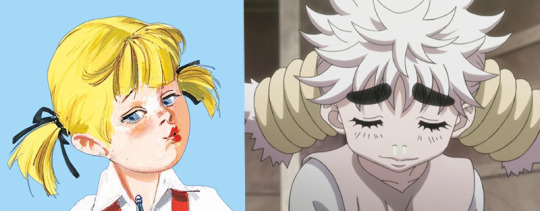
Bonus Section: Meruem’s Name

Although not containing as much lore as his Royal Guard, the King’s given name can give us a few fun tidbits in keeping with the etymology of the Guard.
As you know, in-universe, the Chimera Ant Queen states her son’s name, Meruem, to mean “the light that illuminates/shines on everything”. His name is very close to the common Arabic name, Maryam (مريم), which has multiple romanized spellings. The most notable use of this name is in Biblical history as a form of the name Mary, who was the mother of Jesus, and Miriam, who was the sister of Moses.
It is thought that the name might have roots originating in the Egyptian language; the words “mry” (beloved) and “mr” (love) are thought to have been derivatives of the name.This root meaning would work in portraying the love that the Ant Queen had for her son, even before birth.
Other scholars have thought that the Hebrew root words “mr” (bitter) or “mry” (rebellious) were the basis of the name in the case of Miriam, as she was born at a point in history when the nation of Israel was subject to bitter slavery by the Egyptians. “Bitter” and "Rebellious” might be words you could use to describe Meruem, at least when he is first introduced to us. {x} {x}
Other fun tidbits: Meruem’s characteristic “neutral” face expression, young and feminine facial structure, and characteristic “cat eyes” is very reminiscent to a lot of ancient Egyptian art. One that stands out in my mind is the famous Head of Nefertem statue, found in the tomb of King Tutankhamun, which depicts the Pharaoh in question as a child in the form of the god Nefertem (remember him?). Interestingly, both Meruem and Tutankhamen were kings that ascended the throne (and died) very early in their lives. I’ll let you look at the piece and notice the similarities yourself!

~~~~~~
And that about does it for all the conclusions I’ve drawn. I hope you enjoyed reading through this and that it prompted you to do some reading and research of your own! Togashi chocked HxH full of fun little references to things in our real world, and it’s so much fun to do a deep dive to find all this trivia. If you think of/find any other fun things too add to this post, feel free to reply/reblog with additions. Cheers!
#hxh#hunter x hunter#chimera ants#chimera ant royal guard#hxh meta#i totally didnt spend 6 hours on this labour day monday no siree#ive been thinking about this a lot so i hope you enjoy!!!!!!!#long post#mod words#meta
1K notes
·
View notes
Text
Ae/Aer History
Not done on request, I just like them. :)
These pronouns were coined by David Lindsay in his book A Voyage To Arcturus, written in 1920. In chapter sixteen, Leehallfae, a character named Leehallfae is introduced. Ae looks humanoid, but especially androgynous, and is described as "neither man nor woman, nor anything between the two, but was unmistakably of a third positive sex, which was remarkable to behold and difficult to understand."
Since Maskull, the main character, finds that he, she, or it, or any "earthly" pronoun wouldn't apply to Leehallfae, he decides to use the pronoun ae.
Leehallfae belongs to a species called phaen, which is an ancient, nearly extinct, species that predates men and women. Despite being from 1920, the main character uses ae/aer pronouns until (spoiler alert!!!) ae, like basically everyone else in this book, is killed.
Other than there being an entire nonbinary species, A Voyage To Arcturus has a lot of gender exploration and fuckery.
One character, Panawe, started life with both male and female "souls" inside him, and though he would have preferred to live as both, the female sacrificed herself so the male could live fully. Still, he seems to express sadness and a sense of loss at this. Quite possibly bigender, to use today's terminology. There's another character, Oceaxe, who does identify fully as a woman, but is quite gnc. Then Tydomin very explicitly says he wishes to transition from female to male. I don't know how much clearer Lindsay could make it.
Finally, the main character, Maskull- he has several gender crises throughout the book. At one point in the book, he's referred to as a "person of mixed sex," and replies "I have always regarded myself as a man." So, not entirely sure what this implies, but the book holds a lot of ideas about gender, and coining a new set of pronouns is very on brand.
A Voyage To Arcturus only sold about 600 copies, so it wasn't wildly popular within the general public, especially as trans and nonbinary identities became more popular, considering the book was written in 1920. As a result, ae/aer pronouns were not particularly well known.
However, in the last few years, ae/aer pronouns have gained more popularity, with .44% of participants in the 2021 gender census entering those pronouns (which calculates to 196 people). Ae/aer and fae/faer are also considered by some, like the pronouns page on the NDSU website, to be in the same group of pronouns that can be used with or without the F, similar to how ze/hir and ze/zir are grouped together. Since fae/faer is one of the most popular neopronoun sets at 6.4% of respondents, its popularity might account for some of the popularity with ae/aer pronouns as well.
You can read a little more about the history of fae/faer here, if you're curious.
Sources: Voyage to Arcturus ebook, NDSU pronouns page, gender census 2021
#neopronouns#neopronoun history#ae/aer history#ae/aer pronouns#ae/aer#a voyage to arcturus#death mention tw#cursing tw#leehallfae my belovaed 🧡#my gender is also remarkable to behold and difficult to understand
79 notes
·
View notes